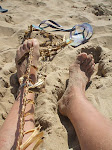 |
"The cure for anything is salt
water: sweat, tears or the sea."
Isak Dinesen, The Deluge at
Norderney, Seven Gothic Tales,
1934
|
Wild, windswept, west facing Atlantic beaches suit me. Perhaps
it has something to do with my Shetland heritage but, maybe, it is also
the Robinson Crusoe in me that knows
there will be flotsam scattered on them. East facing beaches are not the same,
the sun feels as though it is in the wrong place once the spectacle of dawn has
passed and at sunset there are no livid reflections on the water. Town ‘beaches’
don’t really merit the name, surrounded as
they often are by cliffs of flats, cars and intense commerce. I appreciate my
taste in beaches is not everyone’s but the 300km long one pictured above
created by Napolean and his engineers to keep the sea out of Les Landes is really quite
special. Backed by vast man made sand dunes and
around a million hectares of pine forests there are no buildings, cars, sewage
outlets or ice cream sellers and you can walk
miles in each direction and still not find any of those things. Almost every
year I return for a few days to this coast and it never fails to
perform its cure.
Admittedly flotsam has always held a particular attraction for me. I cannot lie around on beaches with idle
hands so I like places where there is a ready supply of materials.
This coast has always obliged in the past with
rope and plastic of all types and in all
colours. Last year I found these small plastic
wheels.
I have no idea what they are, or why they were in the sea, but this
year …..nothing!! The beaches had been cleaned and my source of materials
removed leaving just clean white sand. I walked for hours and only found a handful of short pieces of rope barely enough to make a
table mat. So I just had to lie around and not do anything, and actually
it was quite nice, I might even consider repeating it, one day.
Forty kilometres south of this beach is the town
of Bayonne in the Basque country
and here the Musee Basque beckoned me in. Amongst its treasures were these folded
“handkerchief “ hats, origami with a black handkerchief, one of which appeared also to be woven. The label was skimpy and the on line catalogue
didn’t add anything, but I came to the conclusion that the pattern had in fact been
pressed and starched into the fabric – possibly using a basket as the mould. If
anyone knows more please enlighten me.
Other gems were the little flutes
made of hazel bark used by goatherds in the mountains, I had seen similar
in the Santiago de Compostela museum in Galicia. There were also
beehives and eel traps but I was running out of time and still had not found
any ‘chistera’ (bats for playing jai alai ). Finally
reaching the attic space I found them in a purposely dimly lit room that
resembled a cathedral treasury, I could hardly
make out these poetically arranged precious
‘relics’ in the gloom but their significance in the culture of the region was
evident.
The chistera on
display made of chestnut and willow were all
part of a single collection acquired in the 1950’s, each one slightly different and
strangely mystical displayed in this way. You
can see them in better detail in the Museums online catalogue and read a concise history here of their origin and present day
manufacture by the Gonzales family in Anglet. The Basque country spans the French -Spanish border and many things are the same
either side of the frontier including jai alai
bats. You can read here about a Spanish maker of these bats.









No comments:
Post a Comment